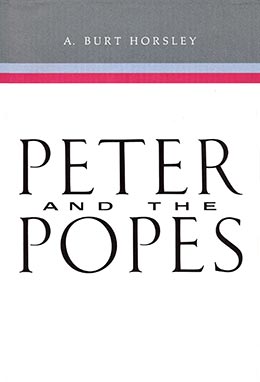Preface
Preface to Peter and the Popes by A. Burt Horsley (Provo, UT: Religious Studies Center, Brigham Young University, 1989), xi–xiii.
Among the religious institutions which have persisted throughout the course of Christian history, none has proven to be of greater durability in the face of opposition and change than the papacy of the Roman Church.
However, there are many convulsive movements abroad today symptomatic of an intellectual disquietude which forbodes a change. The recently completed Second Vatican Council in Rome, functioning not only as a self inquisition but also as a forum of dialogue with the non-Catholic world, has revealed this to be true in a camp formerly regarded as an unwavering bastion of tradition and conservation.
Our time is a time of unconstrained thinking and plain talk. We are living in a day when the assertion is being made repeatedly that Christianity fears no inquiry, in a century that has so abundantly revealed new material and insights. In the spirit of our time, then, we may properly direct attention to the Roman Catholic popes in their historical setting with greater assurance of world-wide approbation. It seems, after all, inevitable that we will eventually know each other in all our perfections and in all our weaknesses.
While spending part of a sabbatical leave in Rome during the Fall and Winter of 1965, and again in 1972, I designed to write an account of the history of the papacy. This has proven to be in part, idealistic. Because of the massive accumulation of centuries of materials in this particular subject matter, to be totally comprehensive would require discursive detailing into a multi-volume work. The alternative is conscientious editing. By this, then, I justify and qualify myself, a presumption to conscience and detachment, being neither Catholic nor Protestant.
The source materials and voluminous writings available for research and study on this subject of the papacy are almost illimitable. This one-volume work, then, represents primarily, a brief survey of the general course of the history of the people and events identified with it.
Since this story can tell only a portion—and a small portion at that—of a sometimes glorious and sometimes notorious past, I have had to select from all the events and people those that seemed most significant to the history of the papacy as an idea. History as it actually occurred was a tangle of confusion, but the idea of the papacy, once established, emerged intact, perpetuating itself into the succeeding age.
The reporter of history gets his facts from certain written or printed documents: diaries, letters, official declarations, legal instruments, eye-witness accounts, and other primary sources which constitute first-hand information. In addition to this, he has to rely on secondary sources, the work of other researchers and historians who have studied the primary sources. This is especially true in a situation such as this where the historical span is so broad as to make impractical and unrealistic a personal examination of all available source materials.
I am indebted to those whose earlier studies and research in the area have produced fruits, the benefits of which have fallen to us, their academic heirs. A great deal of the material here presented is based upon the work of others whose writings are cited in the bibliography. More particularly the commentaries of the great Petrine and early Christian-period traditionalists and classicists such as Dummelow, Edersheim, Farrar, Goodspeed, Harnack, Meyer, Milner, Mosheim and Scott have been studied and compared together with the papal biographers Eusebius, Platina, Flacius, Baronius, and Pastor. The more modern critics Betz, F. M. Braun, Bultmann, Cullman and Dinkier have been valuable sources and the work of Donfried, Reumann and Brown (eds.), especially helpful.
The bulk of this work has grown out of a BYU Leadership Week lecture series, years of teaching the history of the papacy, and from personal source research. For this I must assume full responsibility.
Because of the innate shortcomings of any redaction process it is possible for even the best intentioned author to fall short of satisfying the needs of readers requiring a more exhaustive treatment of special periods of papal history. For this reason, it is advisable to also read books by other authors which might broaden understanding and insight.
I am deeply indebted to my colleague, Professor Rodney Turner, whose critical judgment and assistance in the editing and revision of the New Testament materials on the Apostle Peter have been inestimable. Acknowledgment is also given to suggestions and ideas I have received from Professors Richard L. Anderson, S. Kent Brown, Larry Evans Dahl, C. Wilfred Griggs and Charles D. Tate Jr. Special mention must be made of the support and encouragement given by Dean Robert J. Matthews. I wish to acknowledge Diane Gonzalez and Charlotte Pollard for their editorial assistance and others too numerous to mention by name.
